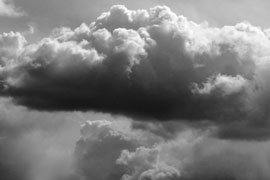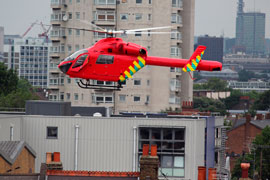April 21st, 2017
Brainstorm: Are Subarachnoid Hemorrhages Affected by the Weather?
Harrison Reed, PA-C
When I walked into the ICU and stared at the roster of current patients, my jaw hit the floor.
“Ho-lee cow,” I said as I scanned the list of diagnoses. The entire unit was full of patients with hemorrhages in their skulls.
“Yeah, man.” The physician finishing the previous night’s shift leaned back in his chair. “Didn’t you feel the change in weather this week? That’s when all of the aneurysms pop.”
Oh, I had felt the change. Or rather, my congested sinuses and obstructed Eustachian tubes had. But it was still my first year at an academic hospital that saw dozens of neurologic catastrophes land on the helipad each month. I had been too focused on keeping patients alive to notice a trend.
 Of course, I know the sayings we toss around on the wards like the tent poles of some unspoken religion: “patients come in streaks,” and “bad things happen in bunches” and “it’s only quiet until you say it’s quiet.” I just always assumed it was superstitious small talk, something to pass the time on a night shift when the patients were asleep and the coffee pot was empty.
Of course, I know the sayings we toss around on the wards like the tent poles of some unspoken religion: “patients come in streaks,” and “bad things happen in bunches” and “it’s only quiet until you say it’s quiet.” I just always assumed it was superstitious small talk, something to pass the time on a night shift when the patients were asleep and the coffee pot was empty.
But perhaps this trend in subarachnoid hemorrhages was something else. Surely, the infinite variables of climate and physiology had the potential to produce a real correlation. Besides, the idea of the weather exacerbating symptoms is not new. Hippocrates noted the effects of wind and rain on human disease as far back as 400 B.C. Even in the 20th century, physicians and laypeople alike thought that inclement weather could trigger severe arthritis pain. This belief was so entrenched that some doctors even advised their patients to move to more temperate regions.
However, no science had ever proven this ubiquitous idea. Was the supposed correlation just an out-of-control superstition? Was it poorly understood pathophysiology? Or something else entirely?
In the 1990s, legendary psychologist Amos Tversky decided to find out. He teamed up with physician Donald Redelmeier and tracked a group of patients with rheumatoid arthritis for 15 months. Tversky and Redelmeier recorded patients’ pain, tenderness, and functional status and matched those parameters with variations in local weather. The two researchers found no significant correlation between symptoms and climate.
The perceived effect, Tversky and Redelmeier postulated, was merely a trick of the mind, a process called selective matching. Patients simply paid more attention to the weather on days they experienced severe pain. On pain-free days, they had better things to think about.
So, was this the answer to my ICU’s streak of subarachnoid hemorrhages? Like the arthritis patients, were my colleagues paying extra attention to the weather when a patient with subarachnoid hemorrhage landed in our unit? Or were the elements actually wreaking havoc on intracranial aneurysms?
Luckily, plenty of researchers had the same question.
In 1994, a group of researchers looked back at 18 months of admissions and found that days with sharp changes in barometric pressure, as well as winter months, correlated with an increase in cases of subarachnoid hemorrhage. However, a 2010 five-year retrospective study examining the same question found that subarachnoid hemorrhage incidence peaked in spring and autumn and was correlated with changes in humidity but not barometric pressure. To further confuse the issue, the very next year a study, claiming to be the largest yet, found no correlation between subarachnoid hemorrhage and changes in season or weather of any kind.
A large meta-analysis joined the fray in 2014 and added its own mud to the water. According to that analysis, January is the peak month for subarachnoid hemorrhages. Of the included studies that broke weather down to specific measurements, just under half showed a correlation with atmospheric pressure, one-third showed a correlation with temperature, and one-fifth linked hemorrhages with humidity. The only problem: not all of the correlations moved in the same direction.
That deluge of conflicting data might make you feel like you need a lumbar puncture of your own. The available research certainly leaves this question unresolved. For now, I’ll continue to check the weather report whenever the neurologic intensive care unit fills up.
But this topic is just one of countless ideas in medicine that could be based on either true physiology or our own flawed psychology. Since writing his arthritis paper, Dr. Redelmeier has gone on to make a career publishing articles with titles like “Driving fatalities on Superbowl Sunday” and “The survival of Academy Award winning actors and actresses.” On your next shift, you might even have time to read them.
That is, if the hospital is quiet and the weather outside is beautiful.
Categories: Clinical Implications of Research, Patient Care
Tags: epidemiology, intensive care, seasonal health disorder, subarachnoid hemorrhage
You can follow any responses to this entry through the RSS 2.0 feed. Both comments and pings are currently closed.
One Response to “Brainstorm: Are Subarachnoid Hemorrhages Affected by the Weather?”

NP/PA Bloggers
Elizabeth Donahue, RN, MSN, NP‑C
Alexandra Godfrey, BSc PT, MS PA‑C
Emily F. Moore, RN, MSN, CPNP‑PC, CCRN
Advanced practice clinicians treating patients in a variety of settings and specialties
Learn more about In Practice: Reflections from NPs and PAs.
-
 NEJM Journal Watch — Recent General Medicine Articles
NEJM Journal Watch — Recent General Medicine Articles NEJM Journal Watch — Recent Pediatrics and Adolescent Medicine Articles
NEJM Journal Watch — Recent Pediatrics and Adolescent Medicine Articles-
Tag Cloud
- addiction adolescent health advanced practice provider clinical role Communication compensation deep brain stimulation diagnostic test discrimination Emergency Medicine empathy end of life Falls Geriatrics gun violence Haiti healthcare access health care quality humanity intensive care intracranial aneurysm legislation lifestyle modification longterm care Massachusetts medical knowledge negotiation neurosurgery NPAEP obesity opioid abuse Parkinson's disease patient-provider communication patient navigation pediatrics performance personal growth practice privileges primary care professional title retirement running team-based health care toxic work culture Vaccination



Great article. You didn’t mention that if you make plans to do something when you are at work or on call(like read those other articles) you will end up with a busy night. And don’t EVEN say the q wordAfter being a PA for 33 years I do think patients(and staff) are crazier around a full moon and when the barametric pressure drops. Also things come in threes and it is always busier the night after a holiday weekend, especially Thanksgiving and Christmas(“But Grandma looks worse than when we saw her last”, When was that ?, “A year ago”) I know the studies don’t back up my thoughts but why would so many healthcare providers feel the same way unless there is something to our “superstitions” Thanks for the article !